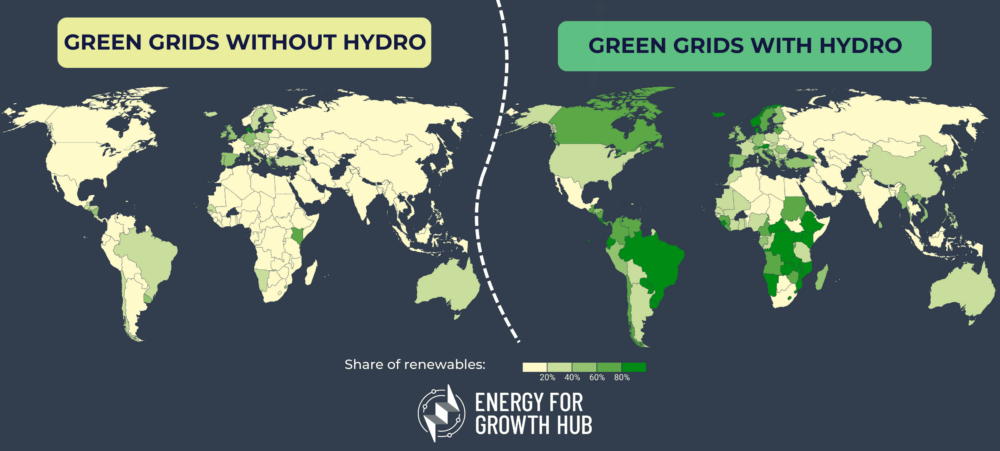In the clean energy world, solar and wind are all the buzz. Hydropower — which remains the largest source of renewable energy worldwide and the biggest contributor to clean grids — is barely mentioned. This disregard for hydropower’s massive contributions doesn’t just distort clean energy debates: It also biases policy and investment discussions, making it harder to deploy hydropower in regions where it is still needed, like Africa.
The deletion by omission
As someone who grew up in Ethiopia, a hydro-dominated country, my appreciation and enthusiasm for hydropower may be a bit much for some. But the real imbalance is the way hydropower is left out of renewable energy conversations, especially in the West, while simultaneously being a cornerstone of many clean economies. Take Norway and Iceland, often praised for their nearly 100% renewable grids, but rarely is it mentioned that 90% of Norway’s and 70% of Iceland’s electricity is derived from hydropower. The omission has seeped into policy too. Even in global conferences like COP29, hydropower is barely mentioned — only featured in a limited initiative focused on modernizing infrastructure in Latin America and the Caribbean. In many Africa-focused conferences — many of which are financed by non-African entities — solar, wind, and even hydrogen dominate the agenda, despite ongoing regional political debates about fair water use. South Asia and Southeast Asia might be the exception, where countries like India, Pakistan, and Indonesia continue to expand their hydropower capacity. But elsewhere, hydropower remains overlooked — a snub that speaks volumes about how energy narratives are shaped.
Explore the map and visualize a world without hydropower.
The rule, not the exception
The truth is, nations across the economic spectrum like Paraguay, Angola, and the Democratic Republic of Congo are reliant on hydropower for nearly all of their electricity. In fact, more than 140 countries have some hydropower in their energy mix. If you look even closer (as we did) at majority-renewable grids worldwide, one thing becomes clear — hydropower is the rule, while wind and solar are the exception. And that shouldn’t be surprising. Hydropower is a mature technology with a high capacity factor (45%), meaning it is very efficient at converting water into large amounts of electricity — on par with fossil fuels. In the rare cases where other renewables play a major role on the grid — say in Kenya or Denmark — geothermal (at capacity factor of 75%) and wind (35%) still outperform solar, which has a capacity factor of around 15%. Don’t get me wrong — I am not saying hydropower is all good (no technology is). Cases where it has had negative social and environmental impacts are well documented. But accurately recognizing both its challenges and its pivotal role enables us to properly weigh the risks and rewards, rather than writing it off entirely.
Why does this matter?
How we talk — or rather, don’t talk — about hydropower downplays its current role and skews our perceptions. When we see maps like this, it’s easy to think, ‘Wow! Look at all that wind and solar powering all those countries,’ — wrongly attributing the wins of hydropower to wind and solar. This misconception carries over into decision making conversations, and hydropower development in regions that still need it is overlooked. It’s crucial to set the record straight on hydropower because:
- Hydropower is responsible for keeping developing economies low-carbon. Africa and Latin America each contribute less than 5% of global energy-related greenhouse gas emissions — thanks to their reliance on hydropower for the majority of their electricity generation (and the fact that they remain energy-poor). The exceptions to this rule are countries supported by geothermal and biomass (also low-carbon sources) in Kenya and Nicaragua, respectively.
- Hydropower enables the integration of other renewables by providing firm, low-carbon, dispatchable power. These features allow hydropower to balance variable electricity from solar and wind, making their adoption more feasible. For instance, Central America’s shift towards more wind and solar — and fewer fossil fuels — over the past decade was enabled by its existing hydropower. Meanwhile, high-renewable but low-hydropower grids in Spain, Greece, and Germany still rely on firm sources — some of which are not low-carbon — to support their transition. Therefore, existing and future hydropower projects in energy-poor regions play a critical role in supporting the adoption of other renewables while ensuring grids remain low-carbon.
- Hydropower capacity additions are stagnating, limiting its role in energy-poor regions like Africa, where it remains underutilized. Hydropower’s omission from the clean energy discourse is reflected in action; the five-year rolling average of new capacity has been declining since 2016 and financing from development finance institutions has been dropping since 2014. While this may have minimal impact on Europe and North America, where a large share of hydropower potential has already been tapped, Africa’s current capacity remains less than a tenth of its techno-economic potential. There are some glimmers of hope, such as the World Bank’s funding approval for the Rogun Hydropower Project in Tajikistan. But the broader silence around hydropower is telling — it reveals exactly where priorities (and funding) are being (not) directed.
Overlooking hydropower’s role — past, present, and future — is a mistake. It has long been a cornerstone of many clean grids and deserves a rightful place in the clean energy conversation. It’s time to bring hydropower back — not just in the media, but in policy and investment discussions, where it truly matters.

